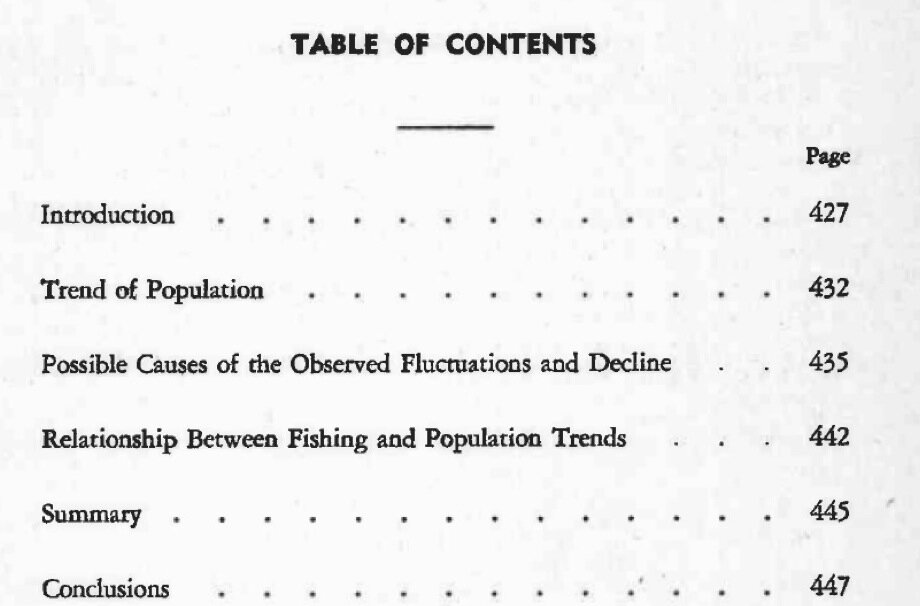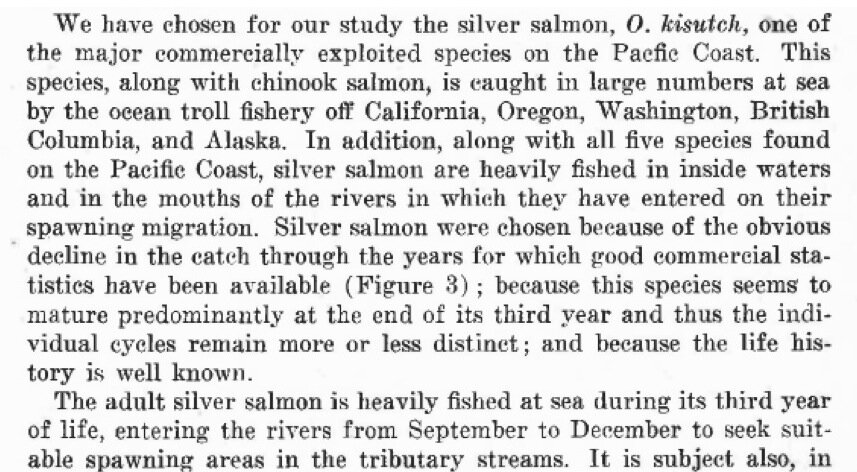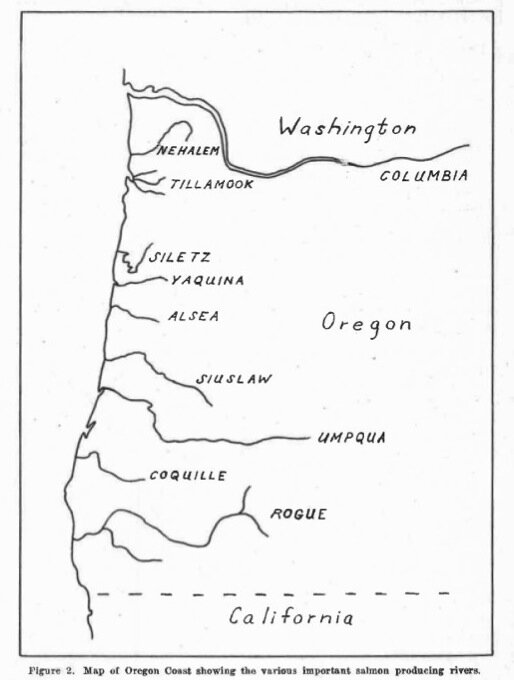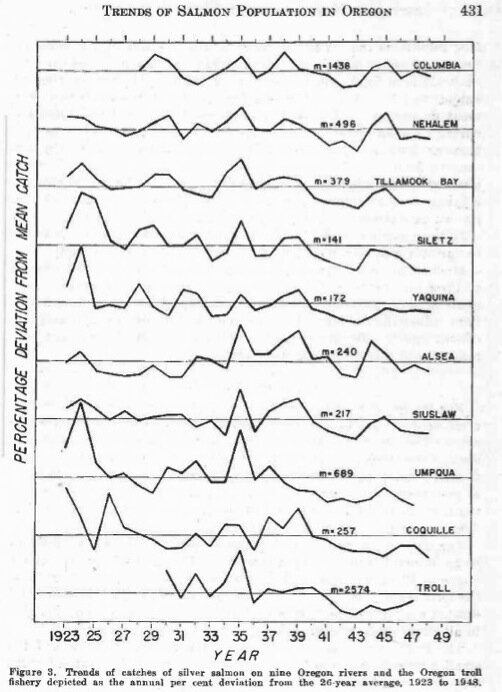In wandering around information on the website (inquiry into declines of Fraser River sockeye), one can find some pretty interesting stuff… that is… I suppose if one is into this sort of thing…
Along the left hand column of the website is the navigation bar — under the “Hearings” tab is a link to “Exhibits”.
There are now over 1000 exhibits. Some with no shortage of pages. I hope that someone is able to do some “key stats” work for the Commission upon its completion. (you know… like baseball stats, or other sports stats.)
Early in the exhibits is information on the structure, plans, budgets, etc. of the Department of Fisheries and Oceans (DFO).
Quite an organization… over 11,000 full time equivalents (FTEs), and an internal structure that resembles a decent size military… in hierarchy and command structure…
Unfortunately, as with all large bureaucracies, it also resembles an obese threatened puffer fish, ready to explode at the seams.
Worse yet… it also resembles a Canadian tar sands operations… sucking up more resources to keep the operation going then actual production — or achieving objectives.
The giant sucking sound is now the sound of resources being consumed to fix, ‘restructure’ and simply ‘control’ this unwieldy behemoth — granted it is most likely one of the smaller “public service” ministries.
_ _ _ _ _ _
A read through some of the ‘organizational’ material submitted to the Cohen Commission as “exhibits”/evidence, rather quickly demonstrates a ministry in deep shit.
Looking through the Department’s “Integrated Business and Human Resources Plan for 2010-11“.
and the 56-page “Report on Plans and Priorities” raises some curious comparisons and thoughts…
Here is a look at annual expenditures — past and forecast for the next while.
And so the annual budget has been over $2 billion annually. Apparently, this is going to be cut by about $200 million over the next 3 years, along with a slight increase in employees, then a decrease…
Combine this with some stats from the shorter integrated planning document…
.
That, apparently commercial fisheries, aquaculture and processing generate about $5 billion in economic activity.
Now, the definition of “economic activity” is a rather broad definition… and… so, here’s a ministry with annual expenditures that are 40% of generated “economic activity”…
…granted there’s also the $7.5 billion or so apparently generated by sport fisheries, however, there is not a significant amount of DFO time or resources spent monitoring these fisheries — at least not in BC (some, but not much).
And there’s even a big disclaimer in the report outlining how DFO shares monitoring and enforcement of the recreational fishery with provincial and territorial governments.
And the “economic activities” generated certainly are not generating revenue to keep the DFO Ministry operational…
_ _ _ _ _ _ _
The integrated and human resource business planning document outlines some other curious issues in this Ministry.
As outlined in the document, this Ministry has a serious problem upcoming. The “Age Distribution” box (top right) showing 40% of their workforce at 50 years or older and that 40% of their workforce is retiring by 2014 (bottom left pie chart).
There’s also this other curious little anecdote that the Ministry wants to cut down hiring time:
“reducing the average time it takes to staff a position to 133 days by implementing components of the national approach to resourcing…”
Wow… if they want to cut down to 133 days — what is it at right now?
So there are over 11,000 full time equivalents in the Ministry — 40% of the workforce is due to retire in less than 5 years (so somewhere around 4,000 to 5,000 people) and the time for hiring new people is going to be cut down to just over 4.5 months…
And yet, the first chart above shows $300 million in budget cuts coming — just as guidance, not as reality — it could be much worse. The Pacific region alone is talking about $50 to $60 million in cuts this year alone.
So how is the Ministry going to do succession planning?
In any business, you don’t just send one person off to retirement and seamlessly ‘integrate’ a new person into the role left and so on… all the way back down the chain.
And so if the Ministry is even successful in cutting hiring times to 4.5 months — that’s still a rough average of say 200 new hires every quarter (4 months) of every year for the next 4 years (and that’s just 4,000 new people to replace the 4,000 to 5,000 lost to retirement).
And don’t forget the classic at work here…that “in a hierarchy every employee tends to rise to his [or her] level of incompetence”, meaning that employees tend to be promoted until they reach a position at which they cannot work competently.
And all of this in a budget slashing environment… gee, sounds like a real secure career choice, and smooth functioning Ministry that’s only responsible for all of Canada’s coastlines (and more).
What else is in the “numbers that matter” above?
In the top centre pie graph is the “FTE’s [full time equivalents] by strategic outcome”. The violet box is “IS” or Internal Services at 18%.
So 18% of the folks working within DFO are simply concerned with the internal workings of the bureaucracy. (Granted, if one did a much more in-depth analysis of people’s time spent working on, stressing about, and dealing with internal staffing, internal politics, and just general internal crap… it would equate to a lot more than 18%).
What is the costs of this I.S. (internal shit)?
Well… that’s outlined in a “financial information” chart.
First thing to point out is that whomever did this chart, maybe didn’t do a very good job of editing.
If you look at the pie charts and accompanying tabular chart below, we’d be led to believe that “Internal Services” (in the purplish color) is responsible for 18% of Capital by SO (strategic outcome)? — the lower left pie chart… but in the table below IS Capital expenditures are more like less than 1% of Capital (e.g. $0.4 million – or $400,000).
…and that Safe and Accesible waterways — the dark blue — is responsible for 81% of capital costs in pie chart, but only 7% in the table.
hmmmm.
Seems there’s some confusion as to which pie chart should be “G & C” (Grants and Contribution) and which chart should be “Capital”. I’m guessing the pie charts are about right… and the table is wrong.
And sooo…the conclusion is that Internal Services are costing the ministry about 20% of its resources — capital including human — in just a financial perspective. Would be curious to determine what all these internal services truly cost in terms of lost productivity, etc. etc.?
_ _ _ _ _ _ _
This 80-20 split in expenditures, costs, etc. between internal vs. external… starts to make me think of the …
The Pareto principle (also known as the 80-20 rule, the law of the vital few, and the principle of factor sparsity) states that, for many events, roughly 80% of the effects come from 20% of the causes.
Business-management consultant Joseph M. Juran suggested the principle and named it after Italian economist Vilfredo Pareto, who observed in 1906 that 80% of the land in Italy was owned by 20% of the population; he developed the principle by observing that 20% of the pea pods in his garden contained 80% of the peas.
It is a common rule of thumb in business; e.g., “80% of your sales come from 20% of your clients”.
Hmmm… so might we conclude that 20% of this Ministry is costing it 80% of its budget?
Or… 80% of the costs are coming from 20% of the Ministry?
Or… that this 20% of “Internal Services” is getting 80% of the work done?
Doesn’t really matter.
_ _ _ _ _ _
Bottom line is — on so many levels — this Ministry is a “sinking ship” and in need of serious restructuring.
Right now it’s tag line could be: “come work for us… we’re slashing budgets, increasing workloads, and operate in a massive military-like bureaucracy… and we blow 20% of our budgets on fiddling internally…”
“… oh yeah, we also protect fish… sometimes… as we did ‘manage’ the North Atlantic Cod into oblivion…”
“… but come work for us anyways..we need YOU…”
_ _ _ _ _ _
… don’t matter how many ‘career fairs’, ‘recruitment rallies’, and ‘university schmooze fests’ you attend with fancy displays (part of “integrated business and human resource strategy”), and beer bongs, and free t-shirts… it’s still a broken ministry.
(all of this said of course with respect to those individuals trying hard to actually keep this ‘ship’ from settling in Davy Jones’ locker… keep up the fight, cuz the basic numbers sure aren’t pretty… or, worse… not always quite right… if a Ministry that is supposed to keep very careful track of fish caught can’t get basic numbers on expenditures correct… where else are ‘numbers’ being fumbled?)
_ _ _ _ _
Fair enough to those that say: “gee, big bureaucratic behemoth… easy target… stop the DFO bashing…”
It’s not a personal thing, it’s simply that so much more efficiency and effectiveness could be realized with a much different operation. Yet, we’re always limited to the two to four year timelines of elections and changes in politicians for any political will to be built to exact change.
And, even when changes are proposed or mandated by Royal Commissions, public inquiries and so on… change comes at the speed of an advancing glacier in Greenland. (oh wait, there aren’t any…they’re retreating…).
For wild salmon — Pacific or Atlantic — change is a must; and rapid change.
The changes they currently face are certainly faster than evolutionary time scales…





















